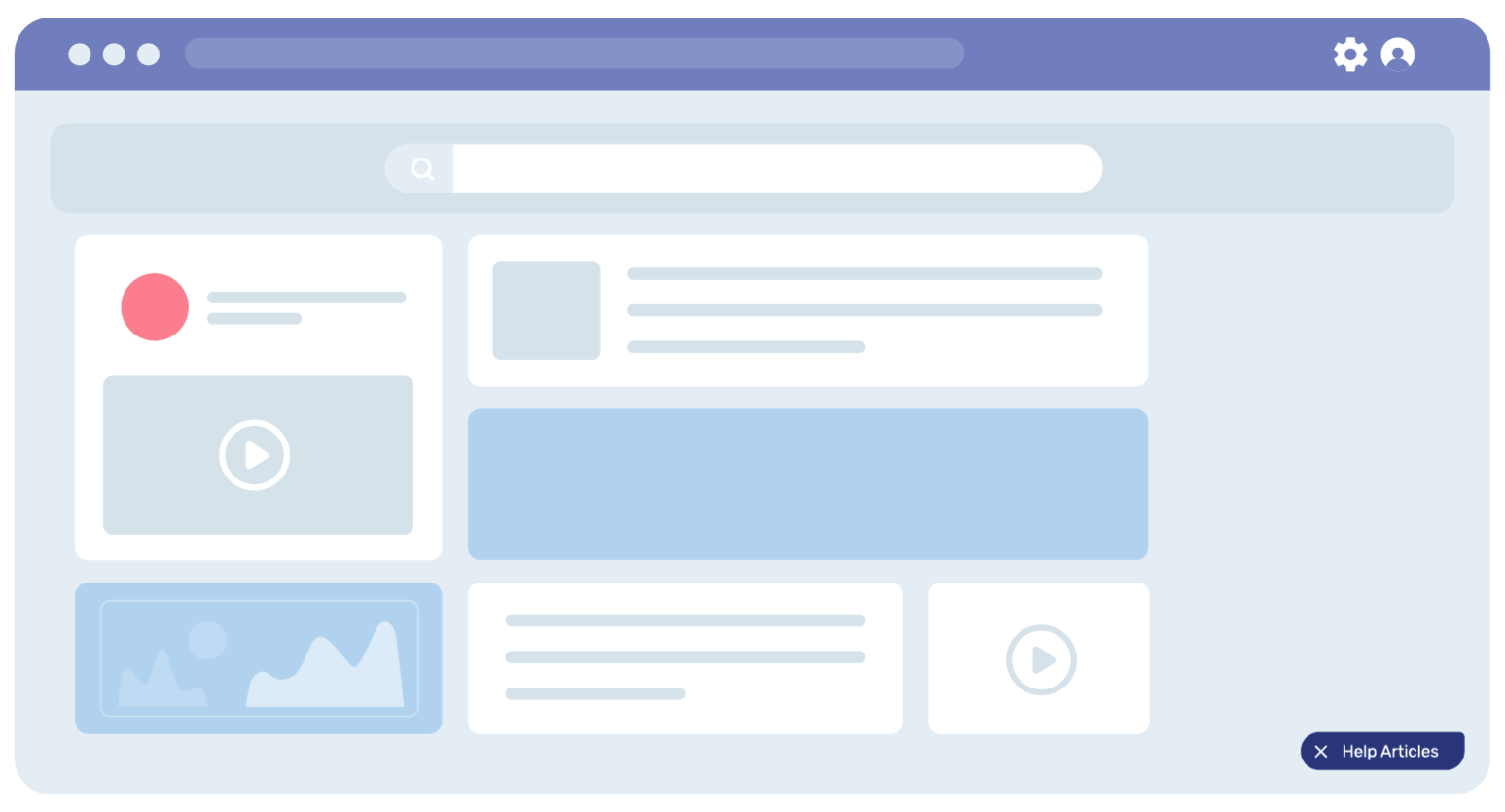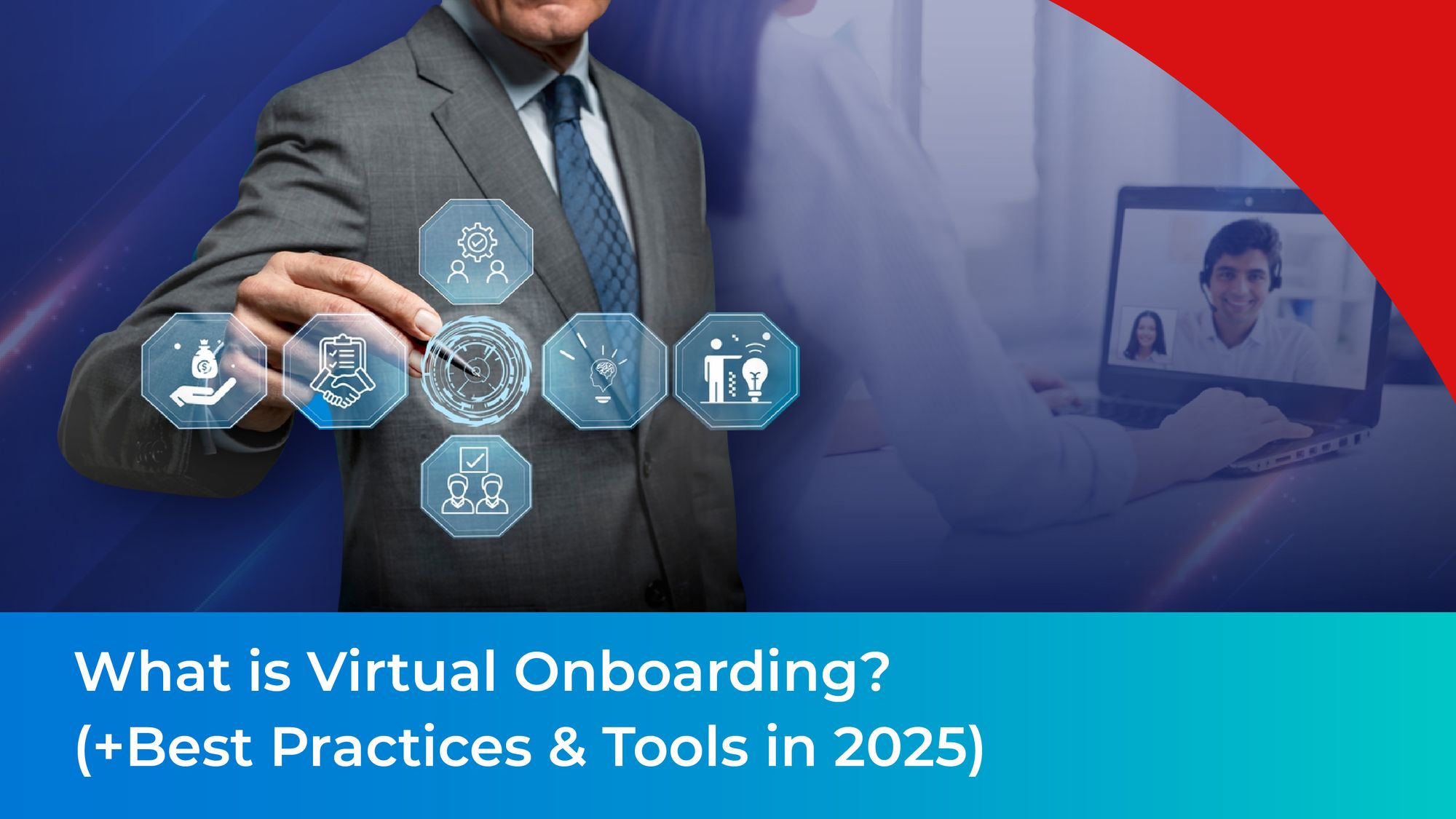Virtual onboarding works for both the employee and the employer.
Research from Harvard and Stanford shows companies can save up to $11,000 a year by going hybrid. And employees?
According to Owl Labs and Global Workplace Analytics, 41% say they’re happier working remotely.
Remote work is no longer a perk. It’s the new normal.
That means the pressure is on L&D teams to make onboarding experiences that are not just informative but actually engaging and supportive.
But it’s not all good news. The same Owl Labs study reports that only 32% of remote employees feel engaged or satisfied in their roles.
That stat matters. Because a weak onboarding process doesn’t just slow people down, it can wear them out.
What we offer:
By the time you're done reading, you'll have all the virtual onboarding best practices at your fingertips, a handy checklist to overlook if you haven't missed anything, and even some cost-effective tools to help you along the way.
What to Expect in this Blog:
- What is Virtual Onboarding
- How Does it Differ from On-site Onboarding?
- Advantages of Virtual Onboarding
- Challenges in Virtual Onboarding
- Best Practices for AHA Virtual Onboarding
- Virtual Onboarding Checklist for Corporate Businesses
- 5 Must-Have Virtual Onboarding Tools
What is Virtual Onboarding?
Virtual onboarding is the process of welcoming and integrating new remote employees into your company using digital tools and resources. It starts even before their first day and continues through initial training and orientation for the first few months.
Effective virtual onboarding helps WFH employees get up to speed quickly and feel valued as team members from day one.
How Does Virtual Onboarding Differ from On-site Onboarding?
After understanding virtual onboarding meaning, we'll see how it differs from on-site onboarding.
Both methods have their strengths and weaknesses, but one thing's for sure: the cost of poor onboarding—whether online or offline—is always high.
According to a Gallup study, when a new hire leaves, it can result in a loss equivalent to around 18 percent of their salary.
That means virtual onboarding carries similar financial risks if not executed effectively.
Advantages of Virtual Onboarding
Looking for the beneficial outcomes once you have implemented virtual onboarding? Let us paint a picture:
Benefit 1/ Smooth Processes Management
With virtual onboarding, everything is (and should be) just a click away.
No more searching through physical files or waiting for responses. New hires can find all the information they need from day one, regardless of the employee's location.
Plus, it ensures consistency in the information and procedures delivered to each new hire. This reduces the risk of errors or missed steps and creates a smoother transition.
Benefit 2/ Offers Diverse Training Formats
Virtual platforms offer a plethora of media options for training.
From engaging videos to interactive documents like PDFs, there's no shortage of creative ways to deliver onboarding content. Real-time tips, multimedia resources, you name it – it's all that you need to bring in-office kinda feels to remote settings.
Benefit 3/ Cuts Down Expenses
It’s no secret that virtual onboarding saves hefty office rent and offline training expenses. It slashes traditional overhead costs associated with physical office spaces and in-person trainers.
Moreover, employees reclaim precious time that would otherwise be spent commuting, translating into increased productivity.
Benefit 4/ Personalized Onboarding Experiences
Virtual onboarding software empowers you to tailor the onboarding experience to individual roles and hierarchies.
Create custom sections, folders, and sub-folders to cater to diverse job requirements. Once set up, you can effortlessly replicate and modify onboarding materials as needed, ensuring a personalized touch for every new hire.
Benefit 5/ Get Insights into Employee Growth
Unlike traditional onboarding methods, virtual platforms offer in-depth analytics to track employee progress.
Monitor completion times, assess course effectiveness, and gather valuable feedback to enhance the onboarding journey continuously.
It's a data-driven approach to refining the employee experience.
Challenges in Virtual Onboarding
As we advance in our understanding of what does virtual onboarding mean, see the image below and tell us if you relate to this.
Sure, connectivity issues can be a challenge of virtual onboarding, but we will go beyond superficial challenges and discuss the substantial ones.
A. Feeling Isolated
Unlike their on-site counterparts, who are constantly surrounded by colleagues, remote workers can feel disconnected if they're not integrated properly into communication channels.
Ensure inclusivity and equity in communication. Providing virtual communication training specific to your company's tools and culture can help bridge this gap.
Additionally, understanding the needs of both introverted and extroverted employees and addressing their feelings of isolation through regular check-ins and feedback sessions is essential.
B. Feeling Hesitant to Ask Questions
Remote workers may hesitate to ask questions, fearing how they will be perceived in text-based communication.
Without the benefit of nonverbal cues like facial expressions and body language, they might worry about coming across as uninformed or incompetent. It's important to establish a culture where asking questions is not only encouraged but celebrated.
Communicate to new hires that asking questions is an integral part of their learning process and fosters collaboration within the team.
C. Feeling Lethargic
Remote work can sometimes lead to feelings of lethargy due to a lack of physical interaction and the presence of distractions at home.
Combatting this requires actively managing feelings of isolation and disconnection through regular team meetings, virtual coffee breaks, or even virtual team-building activities.
Providing resources and support for managing distractions and interruptions, such as setting clear boundaries for work hours and creating dedicated workspaces, can also help remote employees maintain focus and productivity.
As we further discuss virtual onboarding ideas & best practices, it's also important to know the above challenges and then create the best virtual onboarding strategy.
Best Practices for AHA Virtual Onboarding
This is what an expert said about virtual onboarding during Navigate '22, a virtual summit for L&D leaders worldwide.
Here are some basics (best practices) you should know for a successful virtual onboarding:
1. Get New Hires Up to Speed with Process-Oriented Onboarding
Make sure that every aspect of the new hire's experience is guided by clear processes within a systematic framework. From obtaining an I-card to gaining access to HR tools, the onboarding journey should be well-defined and smoothly executed.
When sending equipment to remote workers, set it up with all the software they need. They should be able to start working with just one click or login without needing lots of help over the phone.
Such system-level processes should be simplified and prioritized when mapping out new hires' onboarding plans. This increases the likelihood of a successful onboarding experience.
2. Map Out the Onboarding Journey
Define the roles and responsibilities of key stakeholders involved in the virtual onboarding process, including HR professionals, hiring managers, IT support, department heads, and team members responsible for training or mentoring.
Develop a comprehensive step-by-step outline of the onboarding process, encompassing pre-boarding activities, orientation sessions, IT setup, introductions, training modules, and ongoing support.
3. Identify Essential Tools
Once the onboarding process is outlined, identify the necessary tools to facilitate a smooth experience. Here are some common ones with their use case:
- Communication Platforms: Facilitate employee connection. After setting up email, promptly introduce new hires to relevant groups and individuals on platforms like Slack, Zoom, or Microsoft Teams.
- Learning Management System (LMS): Invest in an LMS (e.g., Moodle, Canvas, TalentLMS) to deliver training modules on onboarding-specific protocols, compliance requirements, and other job-related topics.
- Document Management & Sharing: Implement tools (e.g., Dropbox, Sharepoint) for easy access to essential documents, FAQs, and other resources for new hires to acquire knowledge quickly.
- Virtual Collaboration Tools: Utilize virtual whiteboarding tools (e.g., Miro, Microsoft Whiteboard, Jamboard) to encourage brainstorming and collaboration, replicating the feel of in-office discussions.
- Digital Adoption Tools: Employ solutions that provide in-app walkthroughs and guided tours (e.g., Gyde) to minimize IT support burden while onboarding new hires on CRMs, POS systems, or other work applications.
4. Create Feedback Loops
Implement effective feedback loops to gather insights into new hires' onboarding experiences. Use user-friendly survey tools such as Slido or Mentimeter to collect feedback on various aspects of the onboarding process.
Act upon feedback received, making necessary adjustments to optimize the onboarding journey continually.
5. Take Efforts for Personal Connection
Recognize the importance of fostering personal connections in a virtual environment. One of the most easy-to-do virtual onboarding ideas is to implement initiatives such as regular one-on-one chats using platforms like Donut on Slack to facilitate meaningful employee interactions.
Encourage HR-led virtual team-building activities to cultivate a sense of teamwork and belonging among remote team members, enhancing overall engagement and morale.
Virtual Onboarding Checklist for Corporate Businesses
This was LinkedIn’s Day 1 Checklist. It's a great guide on nitty-gritties of how to do virtual onboarding. From this, we thought we could make a general assumption of what a checklist might look like for your business.
A. Pre-Onboarding (Before First Day):
1. Welcome & Logistics:
- Send a warm welcome email with a clear agenda for the first day and important contact information.
- Finalize paperwork electronically (e.g., tax forms, benefits selection).
- Ship any necessary equipment (laptop, phone, etc.) with clear instructions.
- Set up new hire accounts for essential tools (email, project management, communication platforms).
- Consider sending a small welcome kit with company swag to boost morale.
2. Company & Role familiarization:
- Provide access to a company handbook, training materials, and FAQs.
- Schedule a pre-boarding video call to introduce the company culture, mission, and values.
- Connect the new hire with a "buddy" from their team for informal chats and questions(as suggested by Dr. Nigel Paine in Navigate 22's Employee Onboarding Session)
B. First Day & First Week:
1. Welcome & Introductions:
- Host a virtual welcome meeting with the team and key company personnel.
- Facilitate introductions through icebreaker activities or team introductions.
- Schedule one-on-one meetings with the manager, HR representative, and buddy.
2. Role & Training:
- Review the new hire's job description, responsibilities, and performance expectations.
- Provide role-specific training materials, online courses, or access to a Learning Management System (LMS).
- Schedule regular check-ins with the manager for feedback and support.
3. Company Integration:
- Add the new hire to relevant communication channels (email groups, chat platforms).
- Offer a virtual tour of the company (physical office walkthrough video or virtual office platform).
- Include the new hire in virtual team-building activities or social events.
C. Ongoing Onboarding
1. Continued Learning:
- Set clear goals and expectations for the first 30, 60, and 90 days.
- Provide opportunities for ongoing learning and development (mentorship programs, skill development courses).
- Offer regular feedback and performance reviews.
2. Engagement & Support:
- Encourage open communication and address any questions or concerns promptly.
- Schedule regular check-ins with the manager and buddy to ensure the new hire feels supported.
- Solicit feedback on the onboarding experience and make improvements for future hires.
5 Must-Have Virtual Onboarding Tools
After learning how to do virtual onboarding, here's a breakdown of the 5 virtual onboarding tools mentioned and how they can contribute to a smooth remote onboarding experience:
1. Gyde
- Software Type - No-code Digital Adoption Platform
- Capterra Ratings - 5/5
- Free trial - N/A
- Pricing - Request a personalized quote
Gyde is a digital adoption platform that integrates with any existing or new application your organization may have. It then provides real-time walkthroughs and video guides to help you navigate the software application and become proficient in using it.
It becomes the go-to resource for new hires to access essential information to complete job tasks within a cloud-based or browser application.
Top Features:
- It allows for creating checklist tasks that a new hire must complete and provides step-by-step instructions on how to complete them.
- It lets moderators track new hires' progress(with analytics) on provided help resources.
- It translates help resources into multiple languages to suit the new employee's preferences.
2. TalentLMS
- Software Type - Learning Management System
- Capterra Ratings - 4.7/5
- Free trial - Free plan up to 5 users
- Pricing - Starts at $ 89 /month
TalentLMS is a learning management system (LMS) specifically designed to improve the virtual onboarding process for new employees. It can be a useful tool for conducting virtual onboarding, which involves onboarding new hires remotely without them needing to be physically present at an office.
You can upload various training materials, such as videos, documents, presentations, etc. This eliminates the need for physical manuals and handouts.
Top Features:
- It lets you use badges and completion milestones to make the onboarding process more engaging and interactive for new hires.
- It allows you to schedule introductory calls and connect new employees with team members using built-in videoconferencing tools.
- It seamlessly enables HRIS Integration, connecting TalentLMS with your HR solution for a comprehensive overview of new staff progress.
3. Dropbox
- Software Type - Collaboration Software
- Capterra Ratings - 4.5/5
- Free trial - 30-day trial
- Pricing - Starts at $16.58 / month
Dropbox, a popular cloud storage service, offers several features that can be valuable tools for virtual onboarding. It lets you easily upload and share onboarding documents like offer letters, handbooks, and tax forms with new hires.
Dropbox Sign can significantly improve efficiency if your onboarding process involves a lot of paperwork that needs signing.
Top Features:
- It lets you create reusable templates for common documents, send them for e-signatures, and track the completion status.
- It sets virtual welcome meetings via Zoom or asynchronously with Dropbox Capture to make introductions more personalized and engaging.
- Use Dropbox Capture to create video tutorials, which can be more interactive than traditional inductions and presentations.
4. Miro
- Software Type - Virtual whiteboarding tool
- Capterra Ratings - 4.7/5
- Free trial - Free plan available
- Pricing - Starts at $8
Miro is a virtual whiteboard platform allowing collaborative brainstorming, mind mapping, and project management. It's a great tool for virtual onboarding process because it enables you to create a shared space where new hires can learn about the company and their role and collaborate with their team members – all remotely.
Top Features:
- Miro’s infinite canvas allows teams to brainstorm, plan, and visualize ideas in real-time, making it ideal for collaborative onboarding sessions.
- With Cursor Tracking, facilitators to see where participants are on the board and ensure they are engaged and following along.
- Facilitation Tools like voting, timer, and screen sharing help keep the onboarding session organized and engaging
5. Zimyo
- Software Type - HR Software
- Capterra Ratings - 4.5/5
- Free trial - N/A
- Pricing - Starts at $80 per user per month
If you're looking for a comprehensive HR solution that includes virtual onboarding functionalities, Zimyo could be a good option to consider.
Zimyo can automate tasks like candidate screening and offer letters, freeing up HR for smoother onboarding. It allows for the creation of a structured onboarding program.
Top Features:
- Digital Onboarding feature allows new employees to document early, complete necessary tasks, and learn about company policies before their start date.
- Zimyo promotes virtual meetings and coffee breaks to help new hires bond with the team. It also suggests assigning a mentor or creating a buddy system to improve performance and morale.
- Attendance Management’s feature helps in tracking the presence and engagement of new hires during the onboarding process
Execute Seamless Application Onboarding with DAP
Onboarding doesn’t have to be overwhelming. Especially when it comes to software, a Digital Adoption Platform(DAP) can simplify the process right at the point of need.
With a DAP, employees or end-users get real-time, step-by-step guidance within the application itself. No context-switching. No waiting for support. Just clear, self-serve help that builds confidence, reduces errors, & boosts productivity from day one.
Take Gyde for example. It’s an AI-powered DAP built for software onboarding. Employees can follow walkthroughs with audio instructions & visual cues, watch short process videos, read contextual help articles (or whatever suits their learning preference). They can even download guides for offline use, making onboarding accessible anytime.
For training creators, AI within Gyde makes walkthrough creation smarter. You can build a step-by-step guide in minutes and (with just a click) convert it into a video, a screenshot-based guide, or even offer it in multiple languages.

Request a free demo with one of Gyde's digital adoption experts. They'll show you how to simplify software onboarding and set your new hires up for success.
FAQs
- What is virtual reality onboarding?
Imagine stepping into a realistic, three-dimensional version of your new workplace on your first day. That's the power of virtual reality (VR) onboarding. It's a new way to onboard employees that uses VR technology to create immersive and interactive training experiences.
Think about it this way: instead of flipping through manuals or watching endless videos, new hires can practice tasks, interact with virtual colleagues, and get a feel for the work environment – all from the comfort of their homes!
- Why does onboarding fail?
Onboarding fails for a few reasons: unclear expectations, information overload, lack of engagement, and feeling disconnected. New hires are left lost without a clear roadmap to success.
- How many days is virtual onboarding?
Virtual onboarding itself doesn't have a set number of days. It's more of a process that can unfold over time.
While there might be an initial period of a few days to a week for paperwork, IT setup, and core company information, onboarding can extend much further. Many companies utilize 30-60-90 day plans to keep integrating new hires into the team and ensuring they have the support they need.

